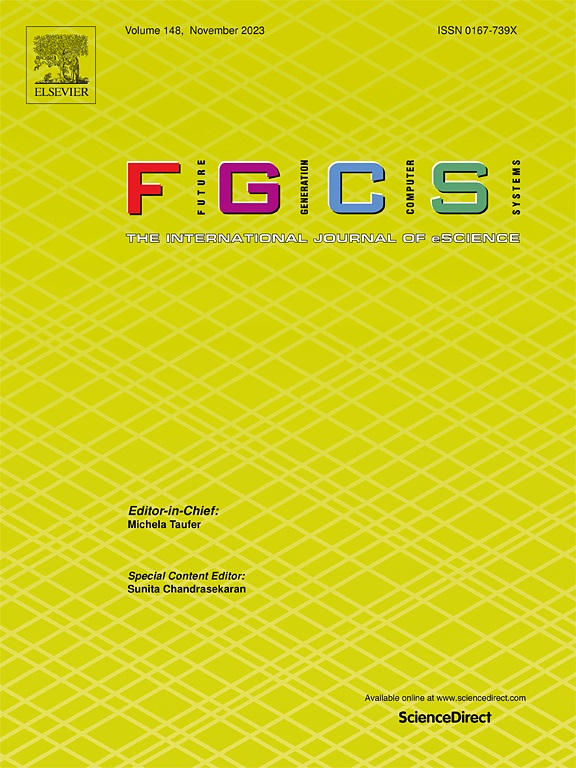FabricTCA: A two-level conflict avoidance approach to consortium blockchains
IF 6.2
2区 计算机科学
Q1 COMPUTER SCIENCE, THEORY & METHODS
Future Generation Computer Systems-The International Journal of Escience
Pub Date : 2025-07-15
DOI:10.1016/j.future.2025.108029
引用次数: 0
Abstract
Consortium blockchain systems have been recognized as promising infrastructures for data sharing and collaboration among different organizations due to their trustless nature. However, performance bottlenecks have seriously hindered the applications of these systems in many practical scenarios, especially under high transaction volumes. This study identifies two critical factors affecting system performance: intra-block and inter-block transaction conflicts. To address these issues, we present FabricTCA (Fabric Two-level Conflict Avoidance), a method that significantly improves system throughput by mitigating both transaction-level (intra-block) and block-level (inter-block) conflicts. To resolve intra-block transaction conflicts, we propose a scheduling strategy that detects and prevents conflicts by introducing a novel dependency chain data structure and defining the notion of dangerous structures. For inter-block transaction conflicts, we propose a conflicting transaction detection mechanism by constructing a cache during the early ordering service stage, in which detected conflicting transactions will be sent back to clients and resubmitted. Extensive experiments under multiple workload scenarios demonstrate that FabricTCA outperforms state-of-the-art consortium blockchains, such as Hyperledger Fabric (a.k.a. Fabric) and its multiple variants, in terms of throughput, transaction abort rate, transaction execution time, and space utilization. In particular, FabricTCA achieves a 9.51-fold increase in throughput and reduces space consumption by 88.27 % compared to Hyperledger Fabric, showcasing its superior performance. Additionally, FabricTCA demonstrates low storage occupation, strong robustness to attacks and high detection speed.
FabricTCA:联盟区块链的两级冲突避免方法
由于其无需信任的性质,Consortium区块链系统已被认为是不同组织之间数据共享和协作的有前途的基础设施。然而,性能瓶颈严重阻碍了这些系统在许多实际场景中的应用,特别是在高交易量的情况下。本研究确定了影响系统性能的两个关键因素:块内事务冲突和块间事务冲突。为了解决这些问题,我们提出了FabricTCA (Fabric Two-level Conflict Avoidance),这是一种通过减轻事务级(块内)和块级(块间)冲突来显著提高系统吞吐量的方法。为了解决区块内事务冲突,我们提出了一种调度策略,通过引入新的依赖链数据结构和定义危险结构的概念来检测和防止冲突。针对区块间事务冲突,我们提出了一种冲突事务检测机制,通过在排序服务早期构建缓存,将检测到的冲突事务发送回客户端并重新提交。在多种工作负载场景下进行的大量实验表明,FabricTCA在吞吐量、交易中止率、交易执行时间和空间利用率方面优于最先进的联盟区块链,例如Hyperledger Fabric(又名Fabric)及其多种变体。与Hyperledger Fabric相比,FabricTCA的吞吐量提高了9.51倍,空间消耗减少了88.27%,显示出其优越的性能。此外,FabricTCA具有占用存储空间少、抗攻击鲁棒性强、检测速度快等特点。
本文章由计算机程序翻译,如有差异,请以英文原文为准。
求助全文
约1分钟内获得全文
求助全文
来源期刊
CiteScore
19.90
自引率
2.70%
发文量
376
审稿时长
10.6 months
期刊介绍:
Computing infrastructures and systems are constantly evolving, resulting in increasingly complex and collaborative scientific applications. To cope with these advancements, there is a growing need for collaborative tools that can effectively map, control, and execute these applications.
Furthermore, with the explosion of Big Data, there is a requirement for innovative methods and infrastructures to collect, analyze, and derive meaningful insights from the vast amount of data generated. This necessitates the integration of computational and storage capabilities, databases, sensors, and human collaboration.
Future Generation Computer Systems aims to pioneer advancements in distributed systems, collaborative environments, high-performance computing, and Big Data analytics. It strives to stay at the forefront of developments in grids, clouds, and the Internet of Things (IoT) to effectively address the challenges posed by these wide-area, fully distributed sensing and computing systems.

 求助内容:
求助内容: 应助结果提醒方式:
应助结果提醒方式:


